Computerized Accounting: A Cost-Effective Approach for Businesses
VerifiedAdded on 2023/06/03
|9
|3159
|193
Report
AI Summary
This report delves into the realm of computerized accounting, focusing on its potential to reduce costs and enhance efficiency within organizations. The paper begins with an abstract that highlights the advantages of integrating automated systems into accounting departments. It explores how computerized accounting can streamline financial processes, reduce errors, and provide real-time insights into a company's financial position. The report then poses a key research question: "Can accounting software reduce the cost in organization?" The report reviews relevant literature, drawing on the works of Horngren, Weber, Grunland, Longenecker, and others to support its arguments. The discussions section synthesizes the reviewed literature, emphasizing the time-saving and cost-reducing benefits of computerized accounting. The report also discusses the importance of integrating accounting theories with the system to maintain accounting realism. It explores fraud detection, improved customer relations, and overall organizational performance. The report emphasizes the importance of selecting the right software and implementing best practices to maximize the benefits of computerized accounting, ultimately concluding that computerized accounting can significantly reduce costs and improve business outcomes.
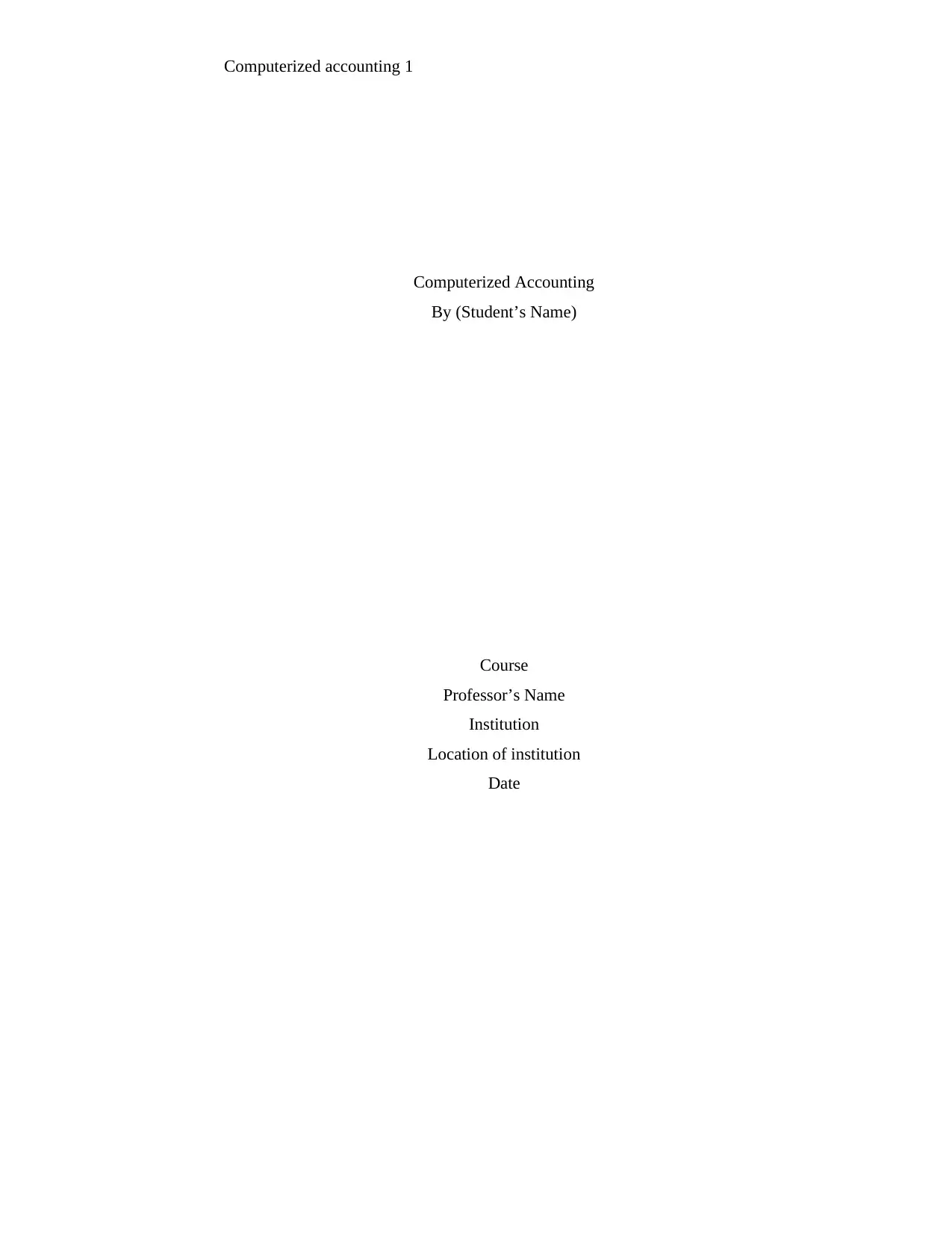
Computerized accounting 1
Computerized Accounting
By (Student’s Name)
Course
Professor’s Name
Institution
Location of institution
Date
Computerized Accounting
By (Student’s Name)
Course
Professor’s Name
Institution
Location of institution
Date
Paraphrase This Document
Need a fresh take? Get an instant paraphrase of this document with our AI Paraphraser
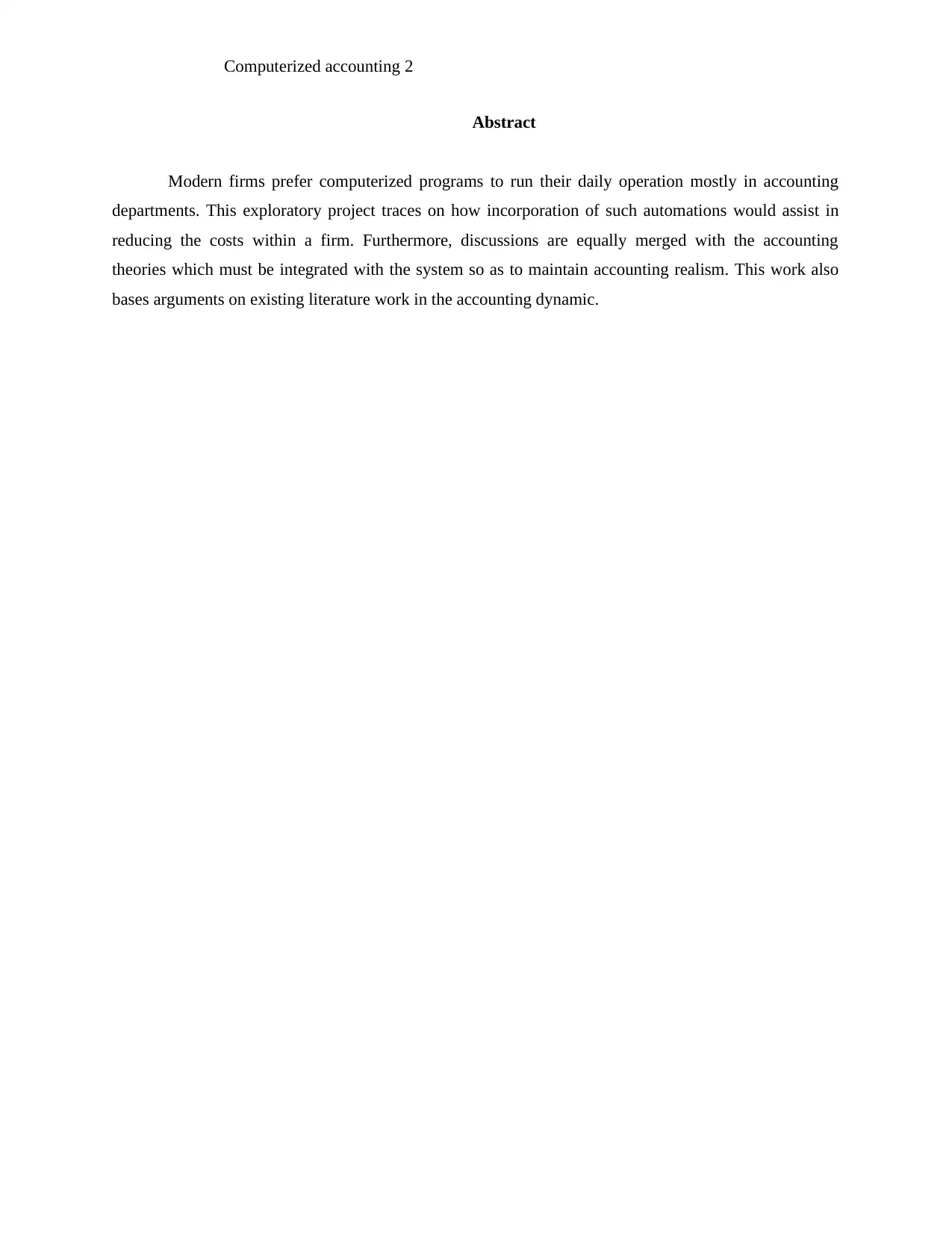
Computerized accounting 2
Abstract
Modern firms prefer computerized programs to run their daily operation mostly in accounting
departments. This exploratory project traces on how incorporation of such automations would assist in
reducing the costs within a firm. Furthermore, discussions are equally merged with the accounting
theories which must be integrated with the system so as to maintain accounting realism. This work also
bases arguments on existing literature work in the accounting dynamic.
Abstract
Modern firms prefer computerized programs to run their daily operation mostly in accounting
departments. This exploratory project traces on how incorporation of such automations would assist in
reducing the costs within a firm. Furthermore, discussions are equally merged with the accounting
theories which must be integrated with the system so as to maintain accounting realism. This work also
bases arguments on existing literature work in the accounting dynamic.
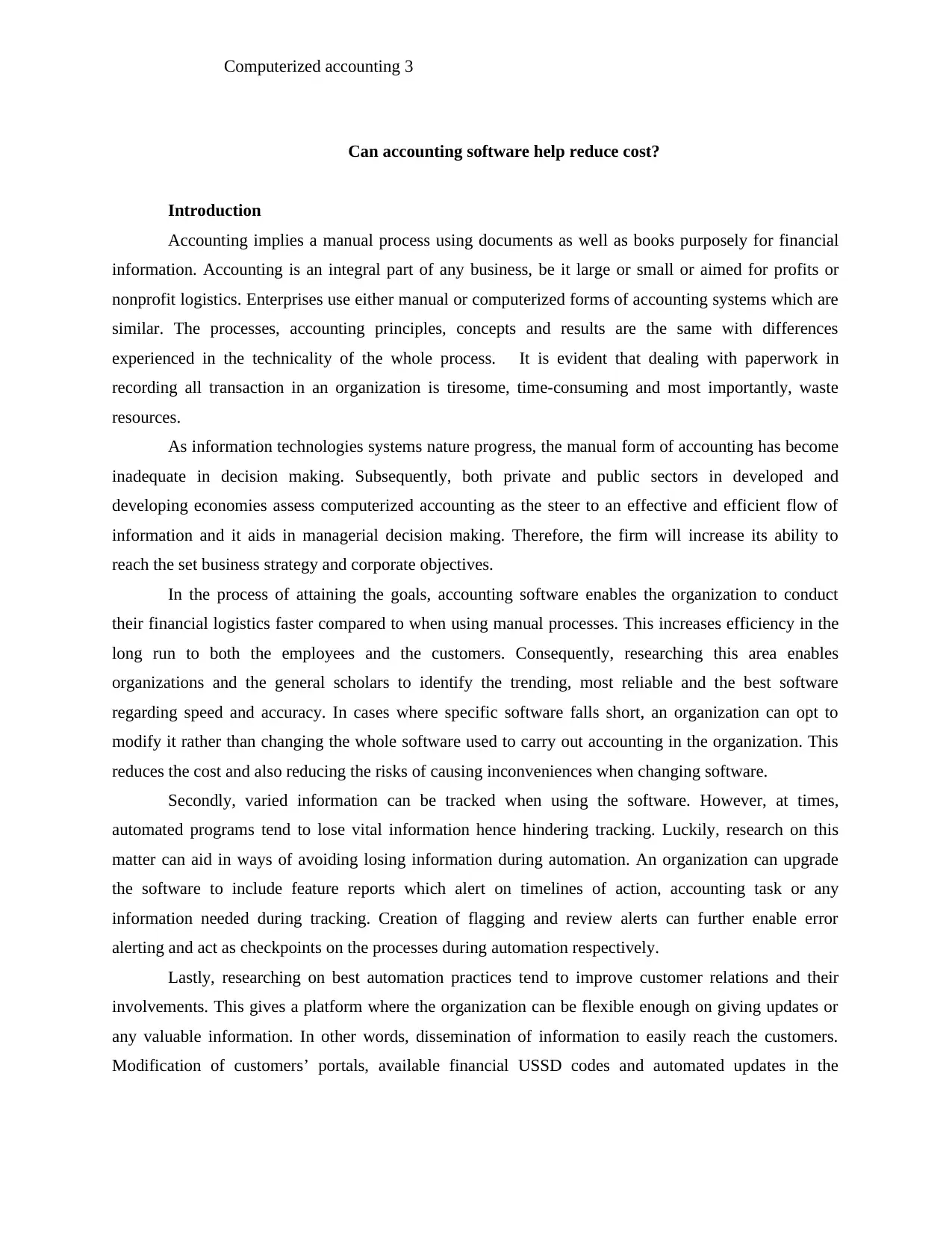
Computerized accounting 3
Can accounting software help reduce cost?
Introduction
Accounting implies a manual process using documents as well as books purposely for financial
information. Accounting is an integral part of any business, be it large or small or aimed for profits or
nonprofit logistics. Enterprises use either manual or computerized forms of accounting systems which are
similar. The processes, accounting principles, concepts and results are the same with differences
experienced in the technicality of the whole process. It is evident that dealing with paperwork in
recording all transaction in an organization is tiresome, time-consuming and most importantly, waste
resources.
As information technologies systems nature progress, the manual form of accounting has become
inadequate in decision making. Subsequently, both private and public sectors in developed and
developing economies assess computerized accounting as the steer to an effective and efficient flow of
information and it aids in managerial decision making. Therefore, the firm will increase its ability to
reach the set business strategy and corporate objectives.
In the process of attaining the goals, accounting software enables the organization to conduct
their financial logistics faster compared to when using manual processes. This increases efficiency in the
long run to both the employees and the customers. Consequently, researching this area enables
organizations and the general scholars to identify the trending, most reliable and the best software
regarding speed and accuracy. In cases where specific software falls short, an organization can opt to
modify it rather than changing the whole software used to carry out accounting in the organization. This
reduces the cost and also reducing the risks of causing inconveniences when changing software.
Secondly, varied information can be tracked when using the software. However, at times,
automated programs tend to lose vital information hence hindering tracking. Luckily, research on this
matter can aid in ways of avoiding losing information during automation. An organization can upgrade
the software to include feature reports which alert on timelines of action, accounting task or any
information needed during tracking. Creation of flagging and review alerts can further enable error
alerting and act as checkpoints on the processes during automation respectively.
Lastly, researching on best automation practices tend to improve customer relations and their
involvements. This gives a platform where the organization can be flexible enough on giving updates or
any valuable information. In other words, dissemination of information to easily reach the customers.
Modification of customers’ portals, available financial USSD codes and automated updates in the
Can accounting software help reduce cost?
Introduction
Accounting implies a manual process using documents as well as books purposely for financial
information. Accounting is an integral part of any business, be it large or small or aimed for profits or
nonprofit logistics. Enterprises use either manual or computerized forms of accounting systems which are
similar. The processes, accounting principles, concepts and results are the same with differences
experienced in the technicality of the whole process. It is evident that dealing with paperwork in
recording all transaction in an organization is tiresome, time-consuming and most importantly, waste
resources.
As information technologies systems nature progress, the manual form of accounting has become
inadequate in decision making. Subsequently, both private and public sectors in developed and
developing economies assess computerized accounting as the steer to an effective and efficient flow of
information and it aids in managerial decision making. Therefore, the firm will increase its ability to
reach the set business strategy and corporate objectives.
In the process of attaining the goals, accounting software enables the organization to conduct
their financial logistics faster compared to when using manual processes. This increases efficiency in the
long run to both the employees and the customers. Consequently, researching this area enables
organizations and the general scholars to identify the trending, most reliable and the best software
regarding speed and accuracy. In cases where specific software falls short, an organization can opt to
modify it rather than changing the whole software used to carry out accounting in the organization. This
reduces the cost and also reducing the risks of causing inconveniences when changing software.
Secondly, varied information can be tracked when using the software. However, at times,
automated programs tend to lose vital information hence hindering tracking. Luckily, research on this
matter can aid in ways of avoiding losing information during automation. An organization can upgrade
the software to include feature reports which alert on timelines of action, accounting task or any
information needed during tracking. Creation of flagging and review alerts can further enable error
alerting and act as checkpoints on the processes during automation respectively.
Lastly, researching on best automation practices tend to improve customer relations and their
involvements. This gives a platform where the organization can be flexible enough on giving updates or
any valuable information. In other words, dissemination of information to easily reach the customers.
Modification of customers’ portals, available financial USSD codes and automated updates in the
⊘ This is a preview!⊘
Do you want full access?
Subscribe today to unlock all pages.

Trusted by 1+ million students worldwide
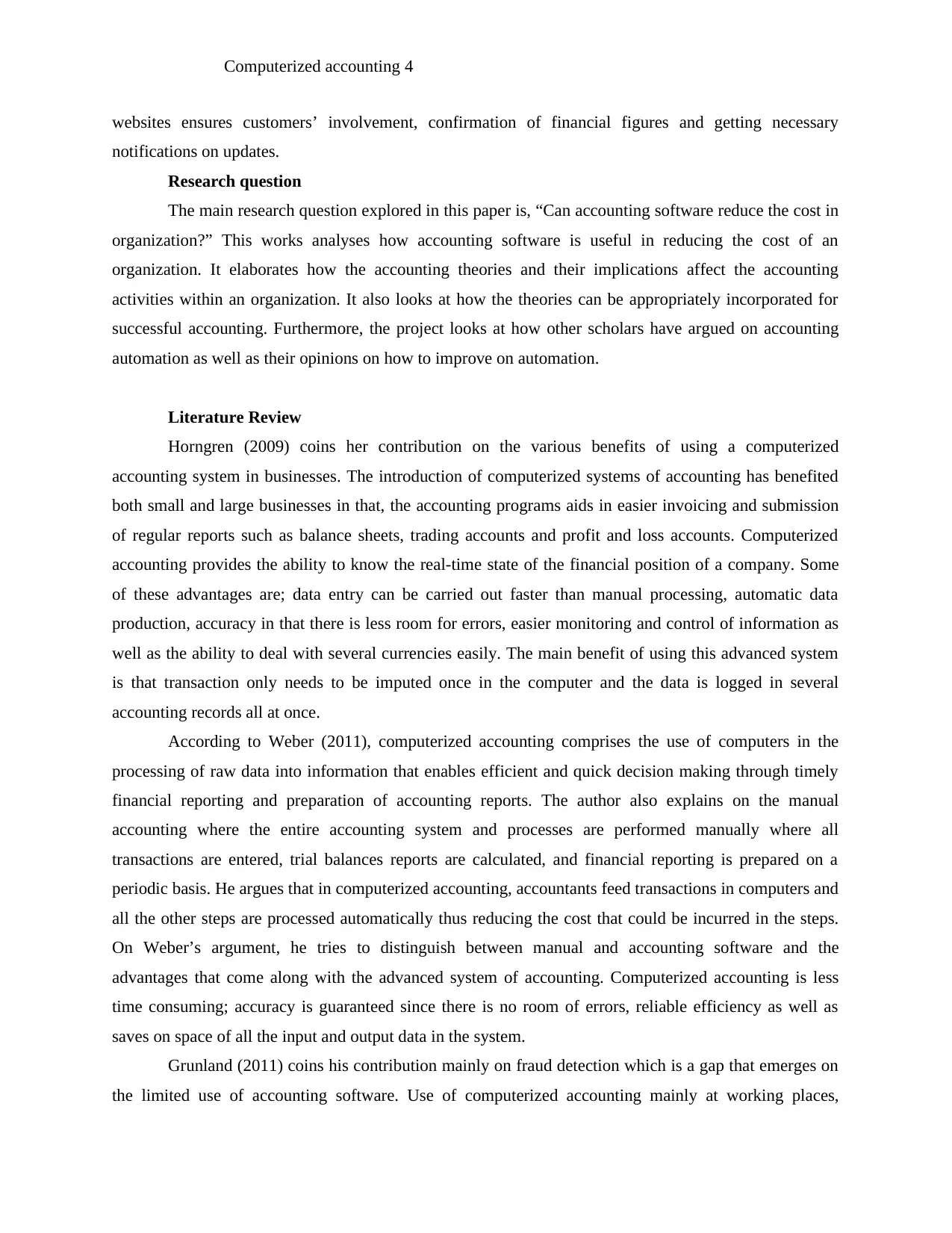
Computerized accounting 4
websites ensures customers’ involvement, confirmation of financial figures and getting necessary
notifications on updates.
Research question
The main research question explored in this paper is, “Can accounting software reduce the cost in
organization?” This works analyses how accounting software is useful in reducing the cost of an
organization. It elaborates how the accounting theories and their implications affect the accounting
activities within an organization. It also looks at how the theories can be appropriately incorporated for
successful accounting. Furthermore, the project looks at how other scholars have argued on accounting
automation as well as their opinions on how to improve on automation.
Literature Review
Horngren (2009) coins her contribution on the various benefits of using a computerized
accounting system in businesses. The introduction of computerized systems of accounting has benefited
both small and large businesses in that, the accounting programs aids in easier invoicing and submission
of regular reports such as balance sheets, trading accounts and profit and loss accounts. Computerized
accounting provides the ability to know the real-time state of the financial position of a company. Some
of these advantages are; data entry can be carried out faster than manual processing, automatic data
production, accuracy in that there is less room for errors, easier monitoring and control of information as
well as the ability to deal with several currencies easily. The main benefit of using this advanced system
is that transaction only needs to be imputed once in the computer and the data is logged in several
accounting records all at once.
According to Weber (2011), computerized accounting comprises the use of computers in the
processing of raw data into information that enables efficient and quick decision making through timely
financial reporting and preparation of accounting reports. The author also explains on the manual
accounting where the entire accounting system and processes are performed manually where all
transactions are entered, trial balances reports are calculated, and financial reporting is prepared on a
periodic basis. He argues that in computerized accounting, accountants feed transactions in computers and
all the other steps are processed automatically thus reducing the cost that could be incurred in the steps.
On Weber’s argument, he tries to distinguish between manual and accounting software and the
advantages that come along with the advanced system of accounting. Computerized accounting is less
time consuming; accuracy is guaranteed since there is no room of errors, reliable efficiency as well as
saves on space of all the input and output data in the system.
Grunland (2011) coins his contribution mainly on fraud detection which is a gap that emerges on
the limited use of accounting software. Use of computerized accounting mainly at working places,
websites ensures customers’ involvement, confirmation of financial figures and getting necessary
notifications on updates.
Research question
The main research question explored in this paper is, “Can accounting software reduce the cost in
organization?” This works analyses how accounting software is useful in reducing the cost of an
organization. It elaborates how the accounting theories and their implications affect the accounting
activities within an organization. It also looks at how the theories can be appropriately incorporated for
successful accounting. Furthermore, the project looks at how other scholars have argued on accounting
automation as well as their opinions on how to improve on automation.
Literature Review
Horngren (2009) coins her contribution on the various benefits of using a computerized
accounting system in businesses. The introduction of computerized systems of accounting has benefited
both small and large businesses in that, the accounting programs aids in easier invoicing and submission
of regular reports such as balance sheets, trading accounts and profit and loss accounts. Computerized
accounting provides the ability to know the real-time state of the financial position of a company. Some
of these advantages are; data entry can be carried out faster than manual processing, automatic data
production, accuracy in that there is less room for errors, easier monitoring and control of information as
well as the ability to deal with several currencies easily. The main benefit of using this advanced system
is that transaction only needs to be imputed once in the computer and the data is logged in several
accounting records all at once.
According to Weber (2011), computerized accounting comprises the use of computers in the
processing of raw data into information that enables efficient and quick decision making through timely
financial reporting and preparation of accounting reports. The author also explains on the manual
accounting where the entire accounting system and processes are performed manually where all
transactions are entered, trial balances reports are calculated, and financial reporting is prepared on a
periodic basis. He argues that in computerized accounting, accountants feed transactions in computers and
all the other steps are processed automatically thus reducing the cost that could be incurred in the steps.
On Weber’s argument, he tries to distinguish between manual and accounting software and the
advantages that come along with the advanced system of accounting. Computerized accounting is less
time consuming; accuracy is guaranteed since there is no room of errors, reliable efficiency as well as
saves on space of all the input and output data in the system.
Grunland (2011) coins his contribution mainly on fraud detection which is a gap that emerges on
the limited use of accounting software. Use of computerized accounting mainly at working places,
Paraphrase This Document
Need a fresh take? Get an instant paraphrase of this document with our AI Paraphraser
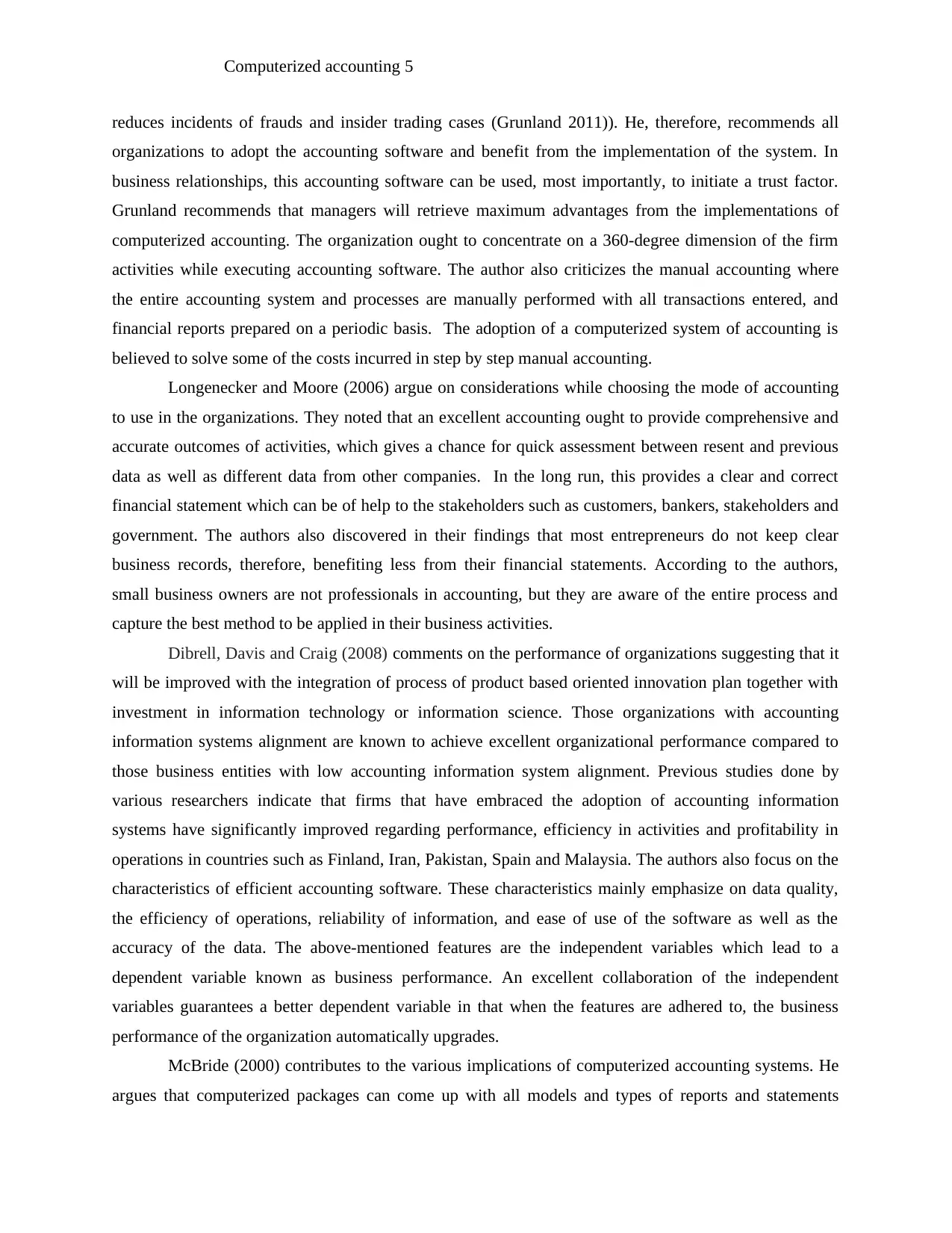
Computerized accounting 5
reduces incidents of frauds and insider trading cases (Grunland 2011)). He, therefore, recommends all
organizations to adopt the accounting software and benefit from the implementation of the system. In
business relationships, this accounting software can be used, most importantly, to initiate a trust factor.
Grunland recommends that managers will retrieve maximum advantages from the implementations of
computerized accounting. The organization ought to concentrate on a 360-degree dimension of the firm
activities while executing accounting software. The author also criticizes the manual accounting where
the entire accounting system and processes are manually performed with all transactions entered, and
financial reports prepared on a periodic basis. The adoption of a computerized system of accounting is
believed to solve some of the costs incurred in step by step manual accounting.
Longenecker and Moore (2006) argue on considerations while choosing the mode of accounting
to use in the organizations. They noted that an excellent accounting ought to provide comprehensive and
accurate outcomes of activities, which gives a chance for quick assessment between resent and previous
data as well as different data from other companies. In the long run, this provides a clear and correct
financial statement which can be of help to the stakeholders such as customers, bankers, stakeholders and
government. The authors also discovered in their findings that most entrepreneurs do not keep clear
business records, therefore, benefiting less from their financial statements. According to the authors,
small business owners are not professionals in accounting, but they are aware of the entire process and
capture the best method to be applied in their business activities.
Dibrell, Davis and Craig (2008) comments on the performance of organizations suggesting that it
will be improved with the integration of process of product based oriented innovation plan together with
investment in information technology or information science. Those organizations with accounting
information systems alignment are known to achieve excellent organizational performance compared to
those business entities with low accounting information system alignment. Previous studies done by
various researchers indicate that firms that have embraced the adoption of accounting information
systems have significantly improved regarding performance, efficiency in activities and profitability in
operations in countries such as Finland, Iran, Pakistan, Spain and Malaysia. The authors also focus on the
characteristics of efficient accounting software. These characteristics mainly emphasize on data quality,
the efficiency of operations, reliability of information, and ease of use of the software as well as the
accuracy of the data. The above-mentioned features are the independent variables which lead to a
dependent variable known as business performance. An excellent collaboration of the independent
variables guarantees a better dependent variable in that when the features are adhered to, the business
performance of the organization automatically upgrades.
McBride (2000) contributes to the various implications of computerized accounting systems. He
argues that computerized packages can come up with all models and types of reports and statements
reduces incidents of frauds and insider trading cases (Grunland 2011)). He, therefore, recommends all
organizations to adopt the accounting software and benefit from the implementation of the system. In
business relationships, this accounting software can be used, most importantly, to initiate a trust factor.
Grunland recommends that managers will retrieve maximum advantages from the implementations of
computerized accounting. The organization ought to concentrate on a 360-degree dimension of the firm
activities while executing accounting software. The author also criticizes the manual accounting where
the entire accounting system and processes are manually performed with all transactions entered, and
financial reports prepared on a periodic basis. The adoption of a computerized system of accounting is
believed to solve some of the costs incurred in step by step manual accounting.
Longenecker and Moore (2006) argue on considerations while choosing the mode of accounting
to use in the organizations. They noted that an excellent accounting ought to provide comprehensive and
accurate outcomes of activities, which gives a chance for quick assessment between resent and previous
data as well as different data from other companies. In the long run, this provides a clear and correct
financial statement which can be of help to the stakeholders such as customers, bankers, stakeholders and
government. The authors also discovered in their findings that most entrepreneurs do not keep clear
business records, therefore, benefiting less from their financial statements. According to the authors,
small business owners are not professionals in accounting, but they are aware of the entire process and
capture the best method to be applied in their business activities.
Dibrell, Davis and Craig (2008) comments on the performance of organizations suggesting that it
will be improved with the integration of process of product based oriented innovation plan together with
investment in information technology or information science. Those organizations with accounting
information systems alignment are known to achieve excellent organizational performance compared to
those business entities with low accounting information system alignment. Previous studies done by
various researchers indicate that firms that have embraced the adoption of accounting information
systems have significantly improved regarding performance, efficiency in activities and profitability in
operations in countries such as Finland, Iran, Pakistan, Spain and Malaysia. The authors also focus on the
characteristics of efficient accounting software. These characteristics mainly emphasize on data quality,
the efficiency of operations, reliability of information, and ease of use of the software as well as the
accuracy of the data. The above-mentioned features are the independent variables which lead to a
dependent variable known as business performance. An excellent collaboration of the independent
variables guarantees a better dependent variable in that when the features are adhered to, the business
performance of the organization automatically upgrades.
McBride (2000) contributes to the various implications of computerized accounting systems. He
argues that computerized packages can come up with all models and types of reports and statements
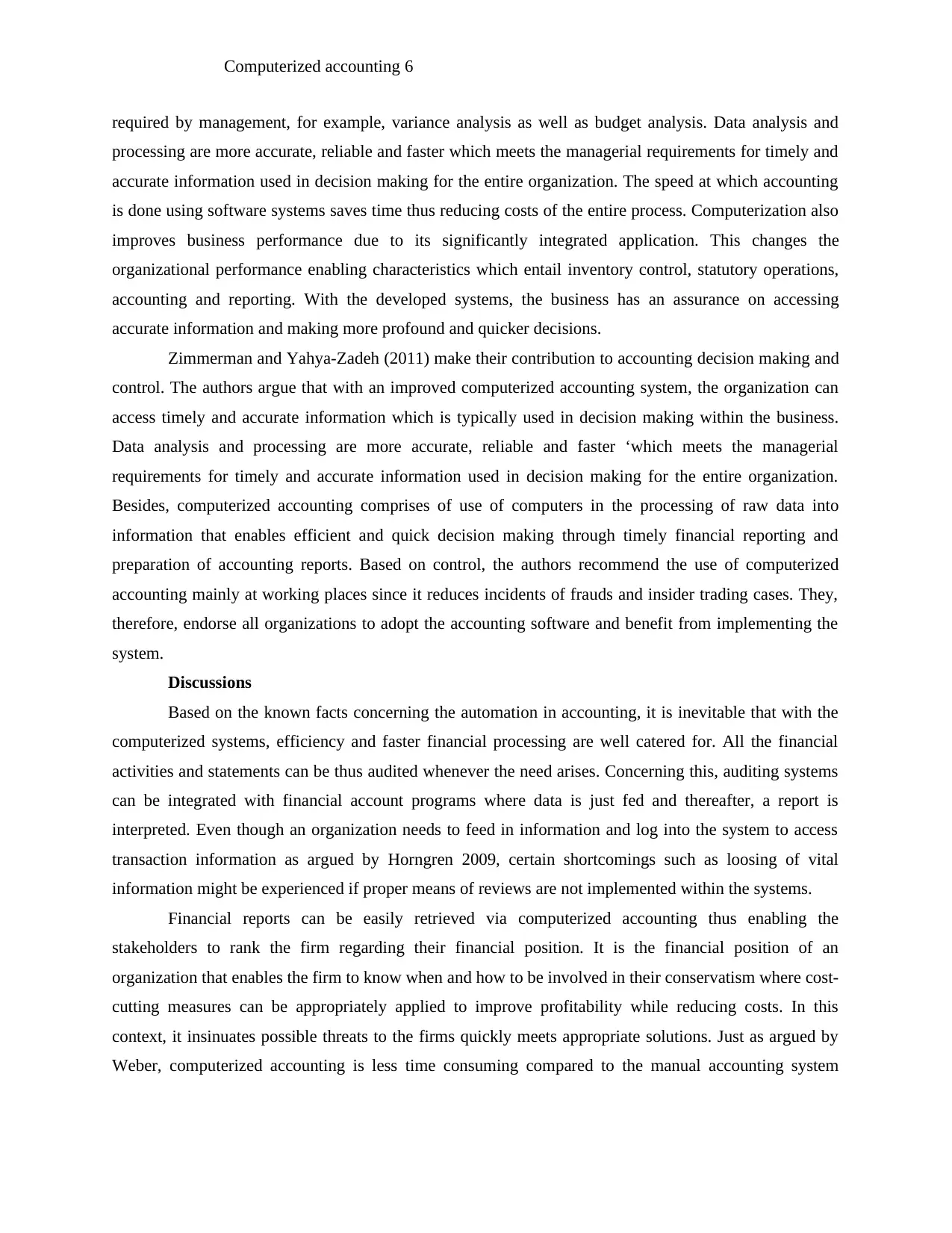
Computerized accounting 6
required by management, for example, variance analysis as well as budget analysis. Data analysis and
processing are more accurate, reliable and faster which meets the managerial requirements for timely and
accurate information used in decision making for the entire organization. The speed at which accounting
is done using software systems saves time thus reducing costs of the entire process. Computerization also
improves business performance due to its significantly integrated application. This changes the
organizational performance enabling characteristics which entail inventory control, statutory operations,
accounting and reporting. With the developed systems, the business has an assurance on accessing
accurate information and making more profound and quicker decisions.
Zimmerman and Yahya-Zadeh (2011) make their contribution to accounting decision making and
control. The authors argue that with an improved computerized accounting system, the organization can
access timely and accurate information which is typically used in decision making within the business.
Data analysis and processing are more accurate, reliable and faster ‘which meets the managerial
requirements for timely and accurate information used in decision making for the entire organization.
Besides, computerized accounting comprises of use of computers in the processing of raw data into
information that enables efficient and quick decision making through timely financial reporting and
preparation of accounting reports. Based on control, the authors recommend the use of computerized
accounting mainly at working places since it reduces incidents of frauds and insider trading cases. They,
therefore, endorse all organizations to adopt the accounting software and benefit from implementing the
system.
Discussions
Based on the known facts concerning the automation in accounting, it is inevitable that with the
computerized systems, efficiency and faster financial processing are well catered for. All the financial
activities and statements can be thus audited whenever the need arises. Concerning this, auditing systems
can be integrated with financial account programs where data is just fed and thereafter, a report is
interpreted. Even though an organization needs to feed in information and log into the system to access
transaction information as argued by Horngren 2009, certain shortcomings such as loosing of vital
information might be experienced if proper means of reviews are not implemented within the systems.
Financial reports can be easily retrieved via computerized accounting thus enabling the
stakeholders to rank the firm regarding their financial position. It is the financial position of an
organization that enables the firm to know when and how to be involved in their conservatism where cost-
cutting measures can be appropriately applied to improve profitability while reducing costs. In this
context, it insinuates possible threats to the firms quickly meets appropriate solutions. Just as argued by
Weber, computerized accounting is less time consuming compared to the manual accounting system
required by management, for example, variance analysis as well as budget analysis. Data analysis and
processing are more accurate, reliable and faster which meets the managerial requirements for timely and
accurate information used in decision making for the entire organization. The speed at which accounting
is done using software systems saves time thus reducing costs of the entire process. Computerization also
improves business performance due to its significantly integrated application. This changes the
organizational performance enabling characteristics which entail inventory control, statutory operations,
accounting and reporting. With the developed systems, the business has an assurance on accessing
accurate information and making more profound and quicker decisions.
Zimmerman and Yahya-Zadeh (2011) make their contribution to accounting decision making and
control. The authors argue that with an improved computerized accounting system, the organization can
access timely and accurate information which is typically used in decision making within the business.
Data analysis and processing are more accurate, reliable and faster ‘which meets the managerial
requirements for timely and accurate information used in decision making for the entire organization.
Besides, computerized accounting comprises of use of computers in the processing of raw data into
information that enables efficient and quick decision making through timely financial reporting and
preparation of accounting reports. Based on control, the authors recommend the use of computerized
accounting mainly at working places since it reduces incidents of frauds and insider trading cases. They,
therefore, endorse all organizations to adopt the accounting software and benefit from implementing the
system.
Discussions
Based on the known facts concerning the automation in accounting, it is inevitable that with the
computerized systems, efficiency and faster financial processing are well catered for. All the financial
activities and statements can be thus audited whenever the need arises. Concerning this, auditing systems
can be integrated with financial account programs where data is just fed and thereafter, a report is
interpreted. Even though an organization needs to feed in information and log into the system to access
transaction information as argued by Horngren 2009, certain shortcomings such as loosing of vital
information might be experienced if proper means of reviews are not implemented within the systems.
Financial reports can be easily retrieved via computerized accounting thus enabling the
stakeholders to rank the firm regarding their financial position. It is the financial position of an
organization that enables the firm to know when and how to be involved in their conservatism where cost-
cutting measures can be appropriately applied to improve profitability while reducing costs. In this
context, it insinuates possible threats to the firms quickly meets appropriate solutions. Just as argued by
Weber, computerized accounting is less time consuming compared to the manual accounting system
⊘ This is a preview!⊘
Do you want full access?
Subscribe today to unlock all pages.

Trusted by 1+ million students worldwide
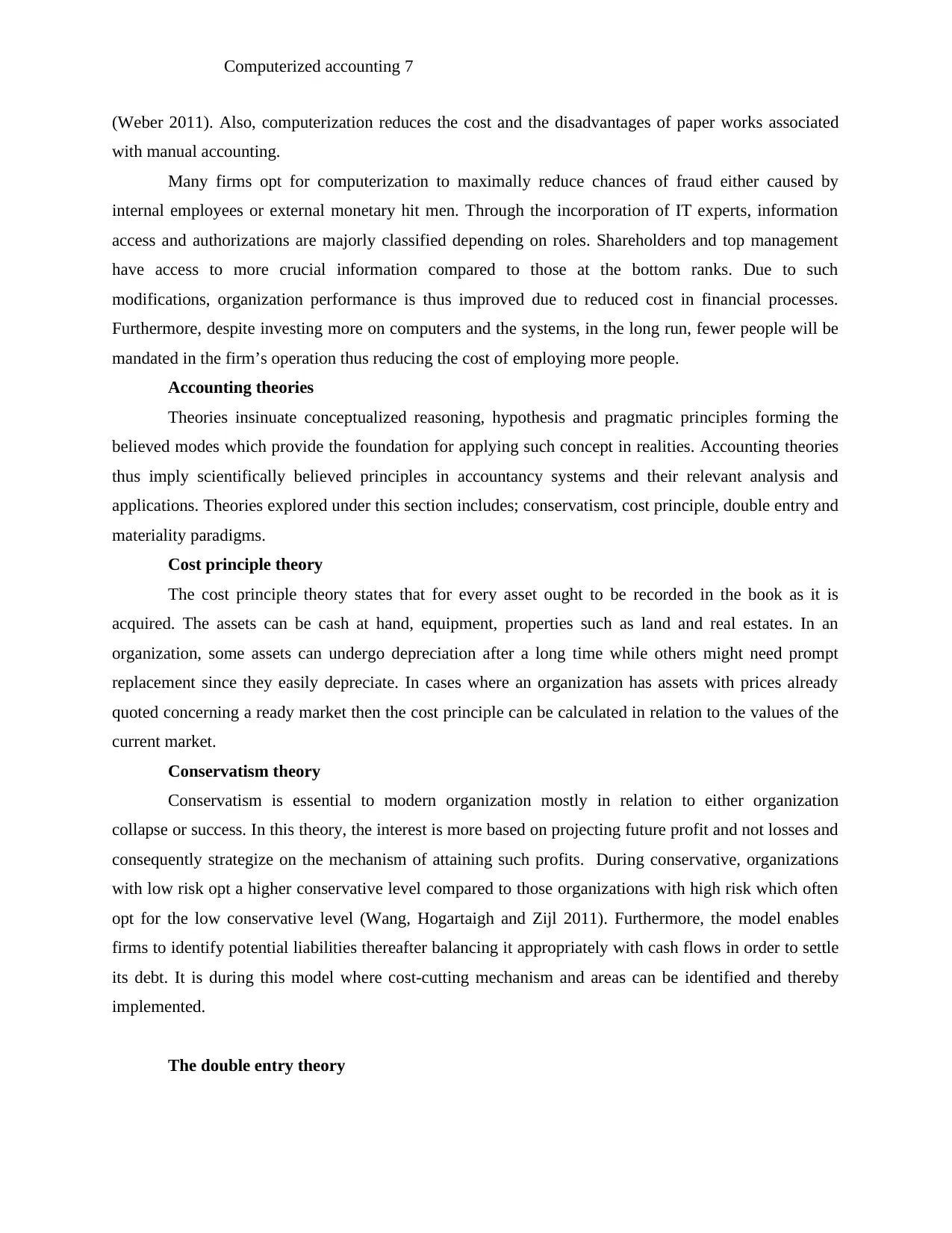
Computerized accounting 7
(Weber 2011). Also, computerization reduces the cost and the disadvantages of paper works associated
with manual accounting.
Many firms opt for computerization to maximally reduce chances of fraud either caused by
internal employees or external monetary hit men. Through the incorporation of IT experts, information
access and authorizations are majorly classified depending on roles. Shareholders and top management
have access to more crucial information compared to those at the bottom ranks. Due to such
modifications, organization performance is thus improved due to reduced cost in financial processes.
Furthermore, despite investing more on computers and the systems, in the long run, fewer people will be
mandated in the firm’s operation thus reducing the cost of employing more people.
Accounting theories
Theories insinuate conceptualized reasoning, hypothesis and pragmatic principles forming the
believed modes which provide the foundation for applying such concept in realities. Accounting theories
thus imply scientifically believed principles in accountancy systems and their relevant analysis and
applications. Theories explored under this section includes; conservatism, cost principle, double entry and
materiality paradigms.
Cost principle theory
The cost principle theory states that for every asset ought to be recorded in the book as it is
acquired. The assets can be cash at hand, equipment, properties such as land and real estates. In an
organization, some assets can undergo depreciation after a long time while others might need prompt
replacement since they easily depreciate. In cases where an organization has assets with prices already
quoted concerning a ready market then the cost principle can be calculated in relation to the values of the
current market.
Conservatism theory
Conservatism is essential to modern organization mostly in relation to either organization
collapse or success. In this theory, the interest is more based on projecting future profit and not losses and
consequently strategize on the mechanism of attaining such profits. During conservative, organizations
with low risk opt a higher conservative level compared to those organizations with high risk which often
opt for the low conservative level (Wang, Hogartaigh and Zijl 2011). Furthermore, the model enables
firms to identify potential liabilities thereafter balancing it appropriately with cash flows in order to settle
its debt. It is during this model where cost-cutting mechanism and areas can be identified and thereby
implemented.
The double entry theory
(Weber 2011). Also, computerization reduces the cost and the disadvantages of paper works associated
with manual accounting.
Many firms opt for computerization to maximally reduce chances of fraud either caused by
internal employees or external monetary hit men. Through the incorporation of IT experts, information
access and authorizations are majorly classified depending on roles. Shareholders and top management
have access to more crucial information compared to those at the bottom ranks. Due to such
modifications, organization performance is thus improved due to reduced cost in financial processes.
Furthermore, despite investing more on computers and the systems, in the long run, fewer people will be
mandated in the firm’s operation thus reducing the cost of employing more people.
Accounting theories
Theories insinuate conceptualized reasoning, hypothesis and pragmatic principles forming the
believed modes which provide the foundation for applying such concept in realities. Accounting theories
thus imply scientifically believed principles in accountancy systems and their relevant analysis and
applications. Theories explored under this section includes; conservatism, cost principle, double entry and
materiality paradigms.
Cost principle theory
The cost principle theory states that for every asset ought to be recorded in the book as it is
acquired. The assets can be cash at hand, equipment, properties such as land and real estates. In an
organization, some assets can undergo depreciation after a long time while others might need prompt
replacement since they easily depreciate. In cases where an organization has assets with prices already
quoted concerning a ready market then the cost principle can be calculated in relation to the values of the
current market.
Conservatism theory
Conservatism is essential to modern organization mostly in relation to either organization
collapse or success. In this theory, the interest is more based on projecting future profit and not losses and
consequently strategize on the mechanism of attaining such profits. During conservative, organizations
with low risk opt a higher conservative level compared to those organizations with high risk which often
opt for the low conservative level (Wang, Hogartaigh and Zijl 2011). Furthermore, the model enables
firms to identify potential liabilities thereafter balancing it appropriately with cash flows in order to settle
its debt. It is during this model where cost-cutting mechanism and areas can be identified and thereby
implemented.
The double entry theory
Paraphrase This Document
Need a fresh take? Get an instant paraphrase of this document with our AI Paraphraser
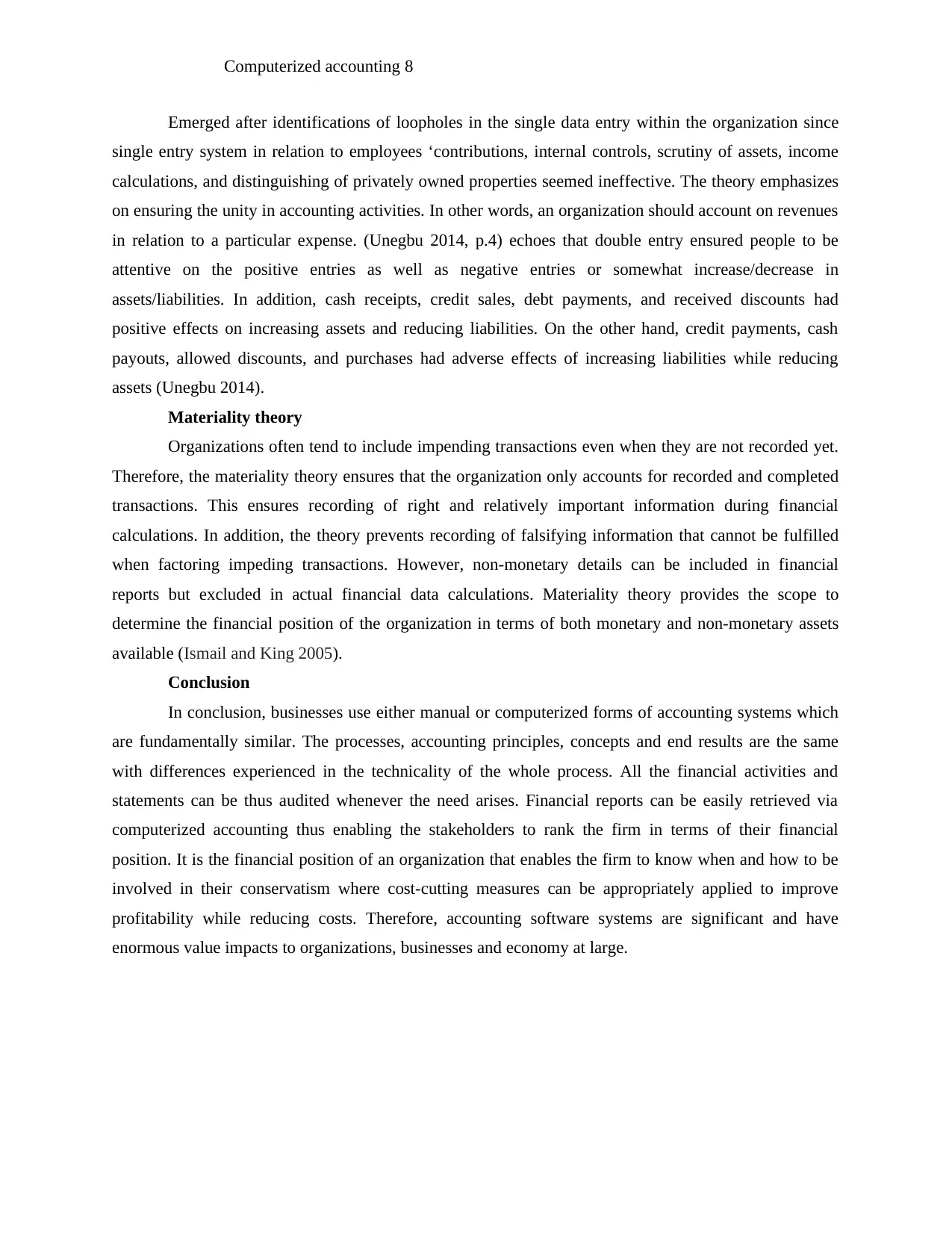
Computerized accounting 8
Emerged after identifications of loopholes in the single data entry within the organization since
single entry system in relation to employees ‘contributions, internal controls, scrutiny of assets, income
calculations, and distinguishing of privately owned properties seemed ineffective. The theory emphasizes
on ensuring the unity in accounting activities. In other words, an organization should account on revenues
in relation to a particular expense. (Unegbu 2014, p.4) echoes that double entry ensured people to be
attentive on the positive entries as well as negative entries or somewhat increase/decrease in
assets/liabilities. In addition, cash receipts, credit sales, debt payments, and received discounts had
positive effects on increasing assets and reducing liabilities. On the other hand, credit payments, cash
payouts, allowed discounts, and purchases had adverse effects of increasing liabilities while reducing
assets (Unegbu 2014).
Materiality theory
Organizations often tend to include impending transactions even when they are not recorded yet.
Therefore, the materiality theory ensures that the organization only accounts for recorded and completed
transactions. This ensures recording of right and relatively important information during financial
calculations. In addition, the theory prevents recording of falsifying information that cannot be fulfilled
when factoring impeding transactions. However, non-monetary details can be included in financial
reports but excluded in actual financial data calculations. Materiality theory provides the scope to
determine the financial position of the organization in terms of both monetary and non-monetary assets
available (Ismail and King 2005).
Conclusion
In conclusion, businesses use either manual or computerized forms of accounting systems which
are fundamentally similar. The processes, accounting principles, concepts and end results are the same
with differences experienced in the technicality of the whole process. All the financial activities and
statements can be thus audited whenever the need arises. Financial reports can be easily retrieved via
computerized accounting thus enabling the stakeholders to rank the firm in terms of their financial
position. It is the financial position of an organization that enables the firm to know when and how to be
involved in their conservatism where cost-cutting measures can be appropriately applied to improve
profitability while reducing costs. Therefore, accounting software systems are significant and have
enormous value impacts to organizations, businesses and economy at large.
Emerged after identifications of loopholes in the single data entry within the organization since
single entry system in relation to employees ‘contributions, internal controls, scrutiny of assets, income
calculations, and distinguishing of privately owned properties seemed ineffective. The theory emphasizes
on ensuring the unity in accounting activities. In other words, an organization should account on revenues
in relation to a particular expense. (Unegbu 2014, p.4) echoes that double entry ensured people to be
attentive on the positive entries as well as negative entries or somewhat increase/decrease in
assets/liabilities. In addition, cash receipts, credit sales, debt payments, and received discounts had
positive effects on increasing assets and reducing liabilities. On the other hand, credit payments, cash
payouts, allowed discounts, and purchases had adverse effects of increasing liabilities while reducing
assets (Unegbu 2014).
Materiality theory
Organizations often tend to include impending transactions even when they are not recorded yet.
Therefore, the materiality theory ensures that the organization only accounts for recorded and completed
transactions. This ensures recording of right and relatively important information during financial
calculations. In addition, the theory prevents recording of falsifying information that cannot be fulfilled
when factoring impeding transactions. However, non-monetary details can be included in financial
reports but excluded in actual financial data calculations. Materiality theory provides the scope to
determine the financial position of the organization in terms of both monetary and non-monetary assets
available (Ismail and King 2005).
Conclusion
In conclusion, businesses use either manual or computerized forms of accounting systems which
are fundamentally similar. The processes, accounting principles, concepts and end results are the same
with differences experienced in the technicality of the whole process. All the financial activities and
statements can be thus audited whenever the need arises. Financial reports can be easily retrieved via
computerized accounting thus enabling the stakeholders to rank the firm in terms of their financial
position. It is the financial position of an organization that enables the firm to know when and how to be
involved in their conservatism where cost-cutting measures can be appropriately applied to improve
profitability while reducing costs. Therefore, accounting software systems are significant and have
enormous value impacts to organizations, businesses and economy at large.
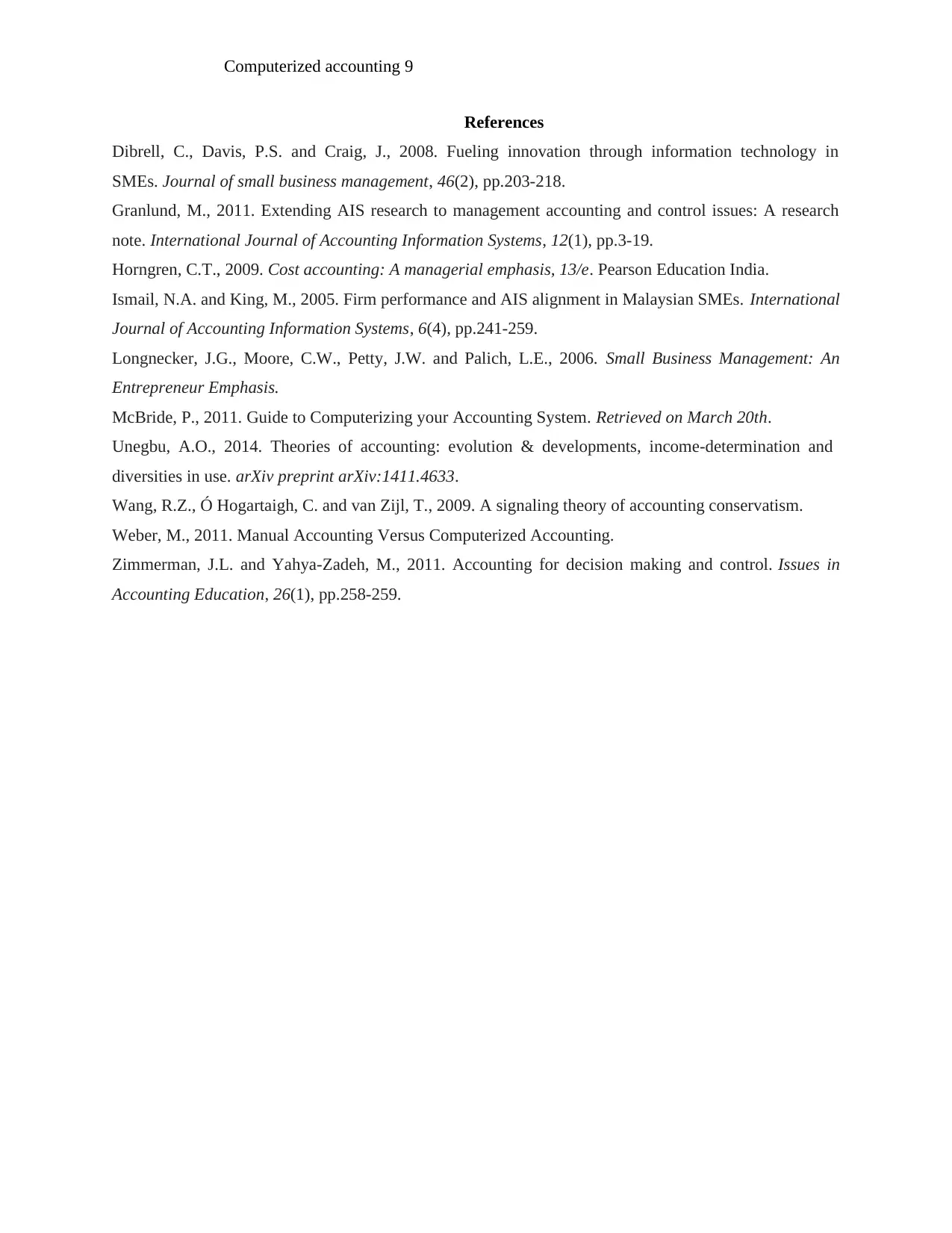
Computerized accounting 9
References
Dibrell, C., Davis, P.S. and Craig, J., 2008. Fueling innovation through information technology in
SMEs. Journal of small business management, 46(2), pp.203-218.
Granlund, M., 2011. Extending AIS research to management accounting and control issues: A research
note. International Journal of Accounting Information Systems, 12(1), pp.3-19.
Horngren, C.T., 2009. Cost accounting: A managerial emphasis, 13/e. Pearson Education India.
Ismail, N.A. and King, M., 2005. Firm performance and AIS alignment in Malaysian SMEs. International
Journal of Accounting Information Systems, 6(4), pp.241-259.
Longnecker, J.G., Moore, C.W., Petty, J.W. and Palich, L.E., 2006. Small Business Management: An
Entrepreneur Emphasis.
McBride, P., 2011. Guide to Computerizing your Accounting System. Retrieved on March 20th.
Unegbu, A.O., 2014. Theories of accounting: evolution & developments, income-determination and
diversities in use. arXiv preprint arXiv:1411.4633.
Wang, R.Z., Ó Hogartaigh, C. and van Zijl, T., 2009. A signaling theory of accounting conservatism.
Weber, M., 2011. Manual Accounting Versus Computerized Accounting.
Zimmerman, J.L. and Yahya-Zadeh, M., 2011. Accounting for decision making and control. Issues in
Accounting Education, 26(1), pp.258-259.
References
Dibrell, C., Davis, P.S. and Craig, J., 2008. Fueling innovation through information technology in
SMEs. Journal of small business management, 46(2), pp.203-218.
Granlund, M., 2011. Extending AIS research to management accounting and control issues: A research
note. International Journal of Accounting Information Systems, 12(1), pp.3-19.
Horngren, C.T., 2009. Cost accounting: A managerial emphasis, 13/e. Pearson Education India.
Ismail, N.A. and King, M., 2005. Firm performance and AIS alignment in Malaysian SMEs. International
Journal of Accounting Information Systems, 6(4), pp.241-259.
Longnecker, J.G., Moore, C.W., Petty, J.W. and Palich, L.E., 2006. Small Business Management: An
Entrepreneur Emphasis.
McBride, P., 2011. Guide to Computerizing your Accounting System. Retrieved on March 20th.
Unegbu, A.O., 2014. Theories of accounting: evolution & developments, income-determination and
diversities in use. arXiv preprint arXiv:1411.4633.
Wang, R.Z., Ó Hogartaigh, C. and van Zijl, T., 2009. A signaling theory of accounting conservatism.
Weber, M., 2011. Manual Accounting Versus Computerized Accounting.
Zimmerman, J.L. and Yahya-Zadeh, M., 2011. Accounting for decision making and control. Issues in
Accounting Education, 26(1), pp.258-259.
⊘ This is a preview!⊘
Do you want full access?
Subscribe today to unlock all pages.

Trusted by 1+ million students worldwide
1 out of 9
Related Documents
Your All-in-One AI-Powered Toolkit for Academic Success.
+13062052269
info@desklib.com
Available 24*7 on WhatsApp / Email
![[object Object]](/_next/static/media/star-bottom.7253800d.svg)
Unlock your academic potential
Copyright © 2020–2025 A2Z Services. All Rights Reserved. Developed and managed by ZUCOL.





